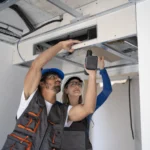This article explores the 2002 S55 AMG rear height leveling sensor symptoms, offering insights into identifying issues and practical tips for troubleshooting.
The 2002 S55 AMG, a flagship performance luxury sedan from Mercedes-Benz, combines exhilarating power with cutting-edge suspension technology. One vital component of this system is the rear height leveling sensor, which ensures optimal ride height for comfort and stability. When this sensor malfunctions, it can cause a cascade of problems that affect both performance and safety.
What Is the Rear Height Leveling Sensor?
The rear height leveling sensor is a critical part of the S55 AMG’s AIRMATIC suspension system. It monitors the distance between the vehicle‘s chassis and the road, adjusting the suspension to maintain a consistent height regardless of load or road conditions. This helps enhance handling, ride comfort, and aerodynamics.
Why the Rear Height Leveling Sensor Matters
Maintaining proper ride height is essential for:
- Safety: Preventing bottoming out or uneven handling.
- Comfort: Smoothing out bumps and rough terrain.
- Performance: Ensuring the suspension adapts to dynamic driving conditions.
A malfunctioning sensor can compromise these advantages.
Common Symptoms of a Faulty 2002 S55 AMG Rear Height Leveling Sensor
Uneven Ride Height
One of the earliest and most noticeable signs is an uneven stance. If the rear of the car sags or sits higher than normal, the sensor might not be correctly reading or adjusting the suspension.
Warning Lights on the Dashboard
Modern vehicles like the S55 AMG feature warning lights. A failing sensor often triggers suspension-related error messages, such as “AIRMATIC Visit Workshop.”
Bouncy or Unstable Ride
When the leveling sensor fails, the suspension may not respond properly, causing excessive bouncing or instability, especially on uneven terrain.
Noisy Suspension Operation
Faulty sensors can lead to incorrect air compressor function, which might produce unusual sounds during operation.
Delayed Suspension Adjustment
A properly functioning AIRMATIC system adjusts the ride height swiftly. If this process becomes sluggish or fails entirely, the sensor could be the culprit.
Sagging Rear End While Parked
If the rear of the vehicle sags when parked for extended periods, it could indicate the sensor isn’t signaling the suspension to maintain height.
Poor Handling Performance
The S55 AMG’s precision handling can suffer due to incorrect suspension adjustments, making cornering less sharp or stable.
Increased Tire Wear
Uneven suspension alignment due to sensor issues often results in abnormal tire wear patterns, particularly on the rear tires.
Unusual Fuel Consumption
Improper aerodynamics from an unbalanced suspension may slightly increase fuel consumption, as the vehicle works harder to maintain performance.
System Failure Noise
A failing sensor can sometimes trigger diagnostic sounds from the onboard system attempting to correct height discrepancies.
Diagnosing Rear Height Leveling Sensor Issues
Visual Inspection
Check for visible damage to the sensor or its linkage. Look for corrosion, wear, or detachment of components.
Diagnostic Scanners
Use an OBD-II scanner with Mercedes-specific capabilities to read fault codes related to the AIRMATIC suspension.
Manual Height Test
Manually measure the rear ride height and compare it with the front. Significant discrepancies may indicate sensor issues.
Listen for Air Compressor Activity
Excessive or non-existent compressor activity often suggests sensor failure or related system issues.
Troubleshooting and Repairs
Replacing the Sensor
If the sensor is confirmed to be the issue, replacing it is a straightforward process, though professional assistance is recommended to avoid calibration errors.
Inspecting the Suspension System
Along with the sensor, check for leaks, worn bushings, or damaged control arms that might exacerbate the issue.
Calibrating the Suspension
After replacing the sensor, recalibration using a Mercedes diagnostic tool ensures the system functions correctly.
Regular Maintenance
Preventative care, such as routine inspections and avoiding overloading the vehicle, prolongs sensor life and prevents costly repairs.
Preventing Rear Height Leveling Sensor Issues
- Clean Components: Regularly remove debris around suspension components to prevent wear and tear.
- Routine Diagnostics: Periodic checks with a Mercedes-certified technician help detect early signs of failure.
- Drive Carefully: Avoid harsh impacts and heavy loads that strain the suspension system.
FAQs 2002 S55 AMG rear height leveling sensor symptoms
What causes the rear height leveling sensor to fail?
- Causes include wear and tear, exposure to debris, electrical faults, or corrosion of the sensor linkage.
Can I drive with a faulty height leveling sensor?
- While possible, it’s not recommended. A malfunctioning sensor can compromise ride quality and safety.
How much does it cost to replace the rear height leveling sensor?
- Costs range from $200 to $600, including labor, depending on the region and technician expertise.
Do I need to recalibrate the suspension after replacing the sensor?
- Yes, recalibration is essential to ensure proper suspension operation and avoid uneven ride height.
How long does a height leveling sensor typically last?
- With proper maintenance, the sensor can last 7–10 years or more, depending on driving conditions.
What other components can fail alongside the height leveling sensor?
- Related failures often include the air compressor, control arms, and air springs.
Conclusion 2002 S55 AMG rear height leveling sensor symptoms
The 2002 S55 AMG rear height leveling sensor plays a pivotal role in maintaining the luxurious ride and precision handling this iconic sedan is known for. Recognizing the symptoms of a failing sensor early can save you time and money while ensuring safety and performance. Regular maintenance and timely repairs are key to preserving the AIRMATIC system’s reliability.











